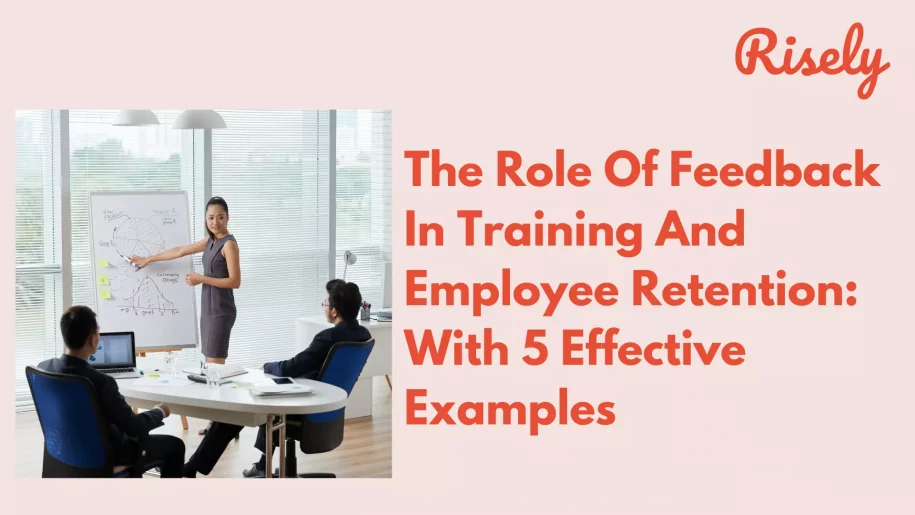The Role Of Feedback In Training And Employee Retention: With 5 Effective Examples
Are you a manager looking to enhance employee retention and drive organizational success? Do you believe that training holds the key to unlocking the full potential of your team members? If so, you’re in the right place! In this blog post, we’ll explore how effective training programs and the integration of feedback loops can transform your team’s dynamics, boost engagement, and create a culture of continuous learning. As a manager, you are pivotal in nurturing a workforce that thrives and remains committed to your organization’s growth. Understanding the link between training and employee retention will give you invaluable insights and practical strategies to empower your team members, elevate their performance, and foster their long-term loyalty. Let’s explore!Understanding the link between Training and Employee Retention
Training and employee retention are closely linked as training programs directly impact employee satisfaction, growth, and engagement within an organization. Training enhances job satisfaction and boosts confidence by providing employees with the necessary skills and knowledge to excel in their roles. Employees who feel competent and supported are likelier to remain loyal to the organization. Furthermore, training programs offer career development and advancement opportunities, demonstrating the organization’s commitment to employee growth. This sense of investment and potential for upward mobility motivates employees to stay within the organization rather than seek opportunities elsewhere. Additionally, training programs foster employee engagement by creating a positive work environment that values learning, collaboration, and skill enhancement. Engaged employees are more likely to be productive, committed, and satisfied with their work, resulting in higher retention rates. Lastly, training equips employees with the necessary skills to adapt to changing industry trends and technological advancements, enabling them to contribute effectively to the organization’s success. By continuously updating employees’ skills and knowledge, organizations ensure their workforce remains competitive, adaptable, and engaged, enhancing employee retention.Other Interesting Reads
Role of Training Feedback in Employee Retention
Training feedback plays a crucial role in employee retention by creating a culture of continuous improvement, addressing individual needs, and enhancing overall training effectiveness. Here are key ways in which training feedback contributes to employee retention:- Individualized Development: Training feedback provides employees with personalized insights into their strengths, areas for improvement, and skill gaps. By receiving constructive feedback, employees understand where they stand regarding their performance and development. This individualized approach to feedback helps employees feel valued and supported, increasing their motivation to stay with the organization and work on their growth.
- Employee Engagement and Satisfaction: Employees who are allowed to provide feedback on training programs demonstrate that their opinions and experiences are valued. This engagement in the feedback process empowers employees and gives them a voice in shaping their learning journey. When their feedback is acknowledged and acted upon, employees feel a sense of ownership and investment in their development, which leads to higher job satisfaction and retention.
- Tailoring Training Programs: Training feedback helps organizations identify gaps and areas of improvement in their training initiatives. By analyzing feedback data, organizations can make informed decisions to refine and tailor their training programs better to meet the needs and preferences of their employees. This customization of training programs enhances their relevance and effectiveness, resulting in higher engagement and retention rates.
- Continuous Improvement and Learning Culture: Training feedback creates an endless improvement loop where employees’ feedback drives enhancements in future training programs. This feedback-driven approach demonstrates an organization’s commitment to ongoing learning and development. Employees are more likely to stay in an environment where their growth is prioritized and their input is valued, fostering a culture of continuous improvement and learning.
- Manager-Employee Relationships: The feedback process fosters open communication and strengthens the relationship between managers and employees. When managers actively seek feedback and engage in constructive discussions with their team members, it builds trust, respect, and a sense of partnership. This positive manager-employee relationship is a significant factor in employee retention, as employees who feel supported and connected to their managers are more likely to stay within the organization.

5 Examples of Training Programs for Employee Retention
- Onboarding and Orientation Programs: A well-designed onboarding program helps new hires feel welcomed and supported. It introduces them to the organization’s culture, values, and expectations and provides job-specific training. Effective onboarding programs ensure employees have a smooth transition into their roles, reducing early turnover and increasing retention.
- Skill Development and Career Advancement Programs: Offering training programs that focus on developing employees’ skills and competencies enhances their performance and demonstrates the organization’s commitment to their growth. These programs can include technical skills training, leadership development initiatives, and workshops on communication, time management, and problem-solving. By investing in employees’ professional development, organizations increase their job satisfaction and provide a clear path for career advancement, thereby boosting retention.
- Mentorship and Coaching Programs: Pairing employees with experienced mentors or providing coaching opportunities can greatly impact retention. These programs offer personalized guidance, support, and feedback, enabling employees to develop professionally and build relationships within the organization. The mentorship or coaching relationship fosters a sense of connection and investment in the employee’s success, leading to increased loyalty and longer-term commitment.
- Cross-Training and Job Rotation Programs: Employees can be exposed to different roles and departments through cross-training and job rotation programs to enhance their skill sets, expand their knowledge base, and increase their value to the organization. These programs promote a culture of continuous learning, keep employees engaged, and provide them with new challenges, reducing the likelihood of boredom or stagnation and improving retention.
- Employee Wellness and Soft Skills Training: Training programs that focus on employee wellness, stress management, work-life balance, and interpersonal skills can contribute to higher retention rates. Organizations create a supportive and inclusive work environment by equipping employees with the tools and strategies to maintain their well-being, handle work-related challenges, and build positive relationships. This leads to increased employee satisfaction and reduced turnover.
Conclusion
Training and employee retention are intricately linked, with training programs catalyzing creating a motivated, skilled, and loyal workforce. By investing in training initiatives, organizations enhance employee skills and job satisfaction and demonstrate a commitment to individual growth and development. Integrating training feedback loops further strengthens this connection by fostering continuous improvement, personalized learning, and a culture of engagement. When employees feel supported, valued, and equipped with the necessary tools to succeed, they are likelier to stay with the organization, contributing to its long-term success and sustainability. Prioritizing training and leveraging feedback loops is a strategic approach that empowers managers to drive employee retention and foster a thriving work environment. Sign up for Risely to get assistance in creating a positive work environment and test your leadership abilities with free assessments.Focus on active listening to spot gender inequality and bias in your team.
Take the free active listening skill assessment to identify weak areas and get support.
FAQs
How does training relate to employee retention?
Training plays a significant role in employee retention by enhancing job satisfaction, improving skills and competencies, providing growth opportunities, and demonstrating investment in employees’ professional development, contributing to their overall engagement and commitment to the organization.
How do you retain employees through training and development?
To retain employees through training and development, organizations can provide ongoing learning opportunities, offer career advancement paths, tailor training programs to individual needs, provide mentoring and coaching support, recognize and reward employee growth, and create a positive learning culture.
What are the 4 pillars of employee retention?
The four pillars of employee retention are competitive compensation and benefits, opportunities for growth and development, work-life balance and well-being initiatives, and a positive organizational culture that fosters engagement and recognition.
Other Related Blogs
What is Immersive Learning? A New Era in Education
In this blog, you’ll learn what is immersive learning and how it is changing training, increasing engagement, and influencing the future of workforce development. … Read More
The Ultimate Guide To Learning Design Tools For 2025
This blog post lists eight essential learning design tools that you need to transform your training programs into powerful learning journeys that inspire and empower every learner to reach their…
Choosing The Right Training Evaluation Tool For Optimal Results
In this blog, we’ll explore how selecting the right training evaluation tool leads to improved performance, more effective training programs, and better overall outcomes for your organization. … Read More
Training Delivery Simplified: Methods, Competencies, and Best Practices
In this blog, we’ll walk you through the training delivery process, the competencies you need, an example of a practical training delivery plan and 8 effective methods. … Read More


